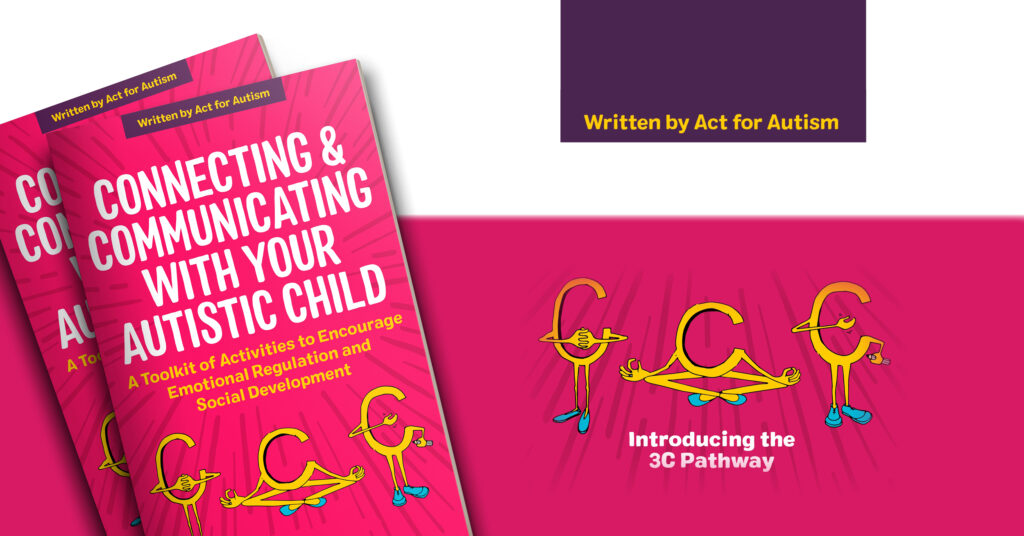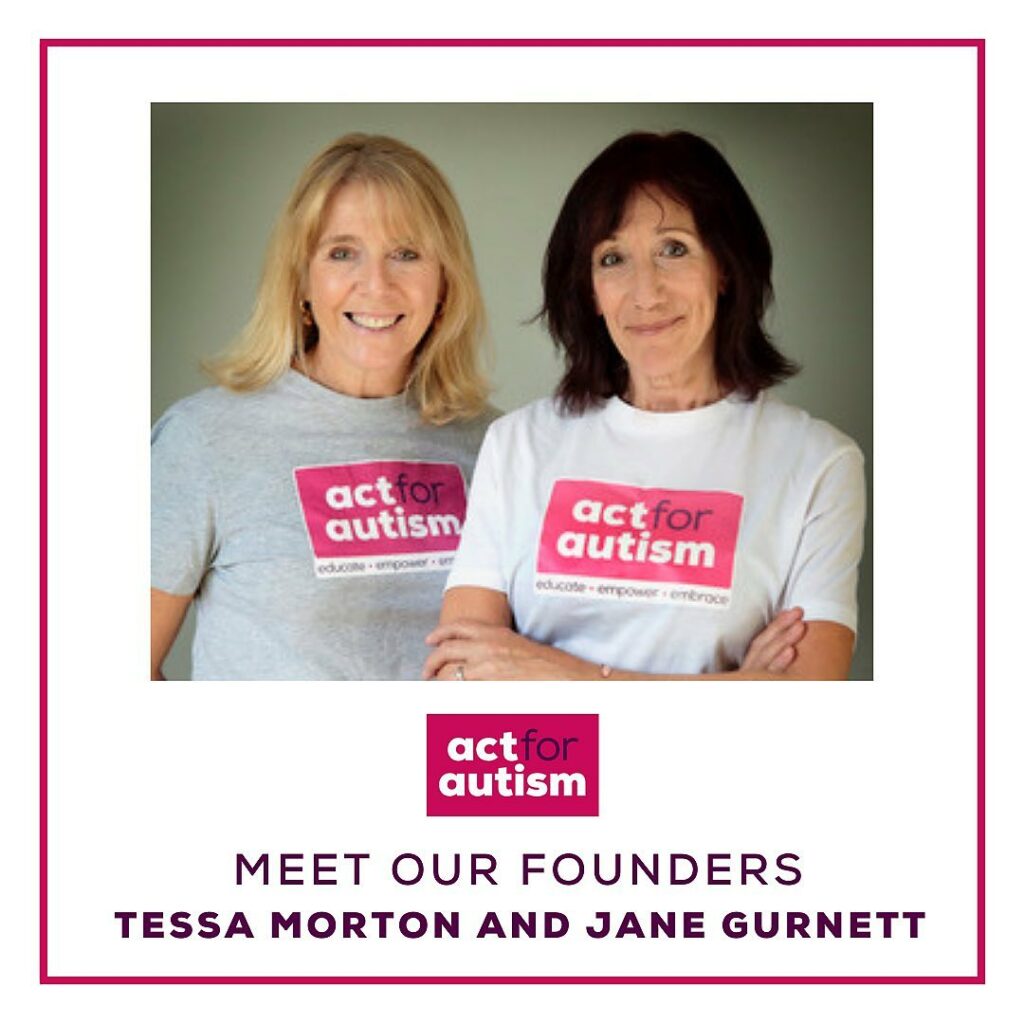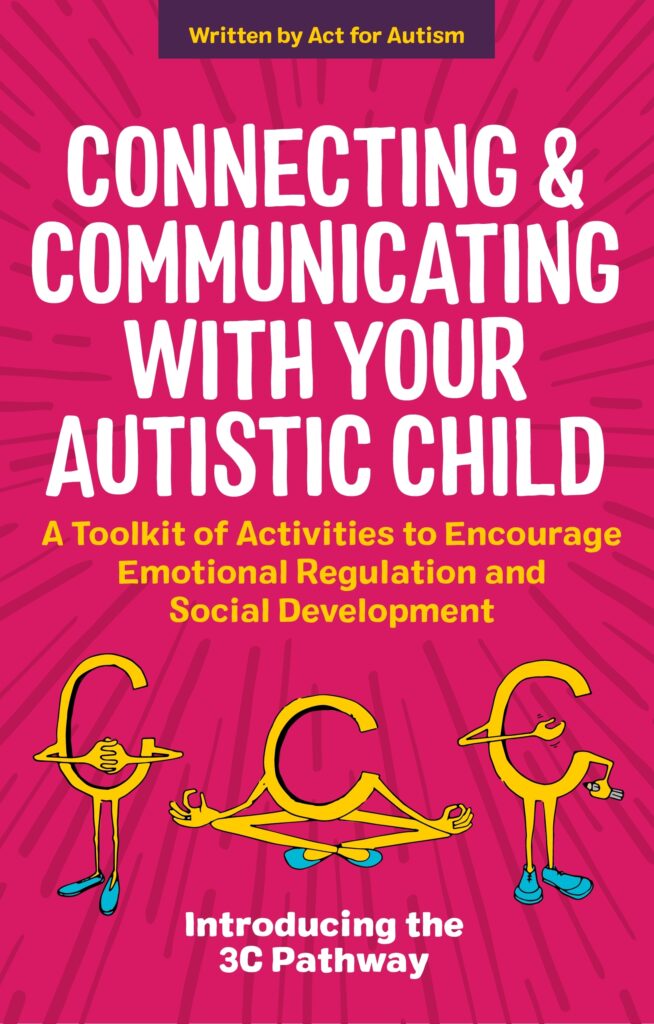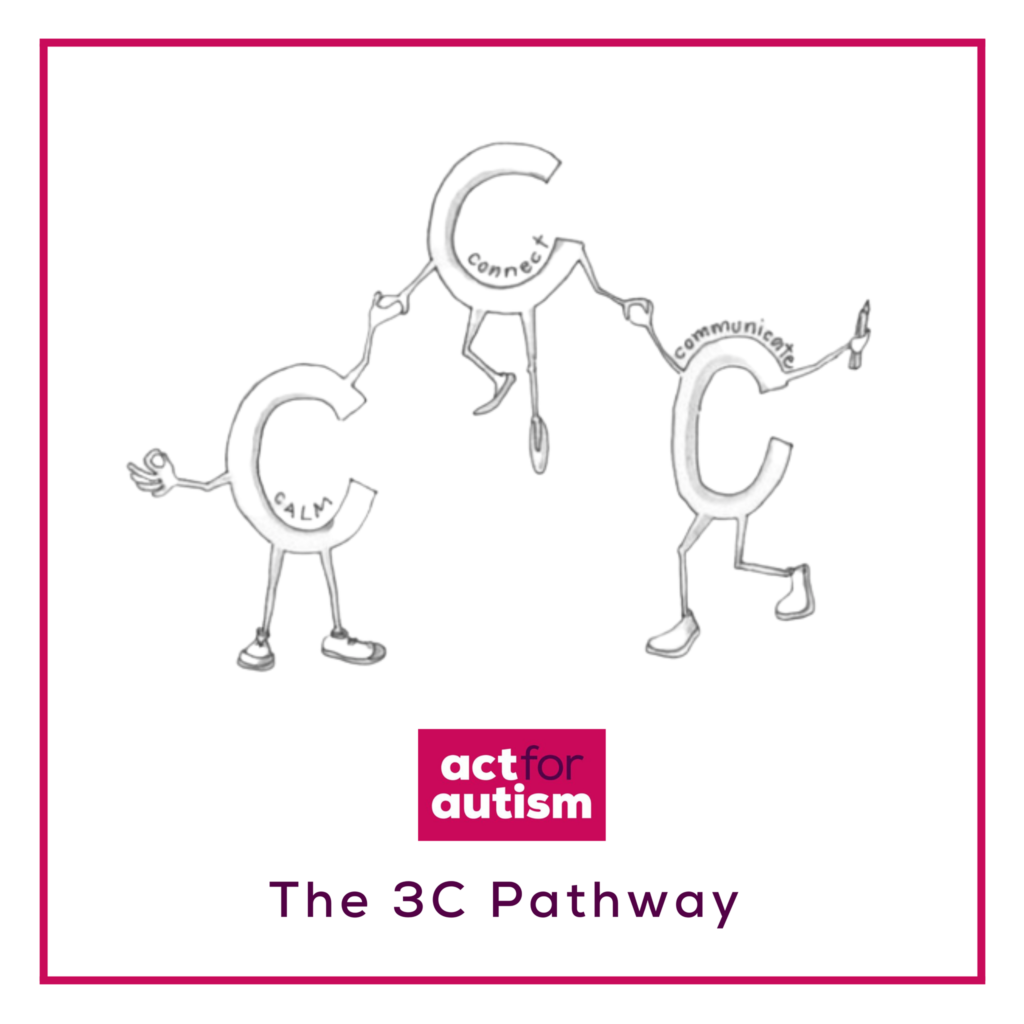Tessa Morton and Jane Gurnett are the founders of Act for Autism and authors of Connecting and Communicating with Your Autistic Child, a book of tried-and-tested, accessible and easy to implement, such as breathing exercises, mirroring movements, and treasure hunts. Using these activities, parents and professionals can gain insight into the sensory and social challenges experienced by those on the spectrum and can work to build a positive and trusting relationship, offering a secure base for children’s emotional development. In this blog piece, Tessa and Jane explain more about their Clear Time technique and the 3C Pathway.

Act for Autism
The 3C Pathway was developed as a result of the work of Act for Autism, a social enterprise company (CIC) based in Warwickshire. It was generated by their work on the ground, and has been, as one of their autistic advocates described, ‘co-constructed’. They followed the lead of the children and young people they work with, and they noticed that when they became present, calmly ‘tuning in’ and emptying themselves of their expectations, reciprocal communication happened.
For many years’ practitioners and parents/carers have focused their work or parenting on changing the responses and ‘behaviours’ of autistic individuals.

Act for Autism’s main ethos is that the change starts with us, and that we all, as parents/carers and professionals, need to empty ourselves of expectations, to trust their communication mode, be present, throw away agendas, be caring, connected and calm. To do this you must to become ‘clear’. This tuning in and emptying one selves, they have called Clear Time which has become a vital part of the 3C Pathway and fundamental to their work at Act for Autism.
They are conscious that, whilst the scientists are looking for the ‘answers’, there is an autistic individual needing emotional understanding, so regardless of the ever-moving science, what is more important is gaining a greater understanding of the challenges that are faced for someone who has to navigate a world designed by neurotypicals for neurotypicals. Neurotypicals often assume that their experience of the world is either the only one or the correct one. Act for Autism believe we need to be ‘sleuthing’ for what makes any individual tick, and empathetically connecting, rather than strategizing the individual from a neurotypical viewpoint.
They ask, does anyone react well to being told how to operate in the world? They believe that prescriptive strategies, by their very nature, are implemented from the perspective of the person doing the strategizing. If that person is neurotypical how can that possibly be helpful. Act for Autism suggest that if a parent/carer or professional wants to advocate they must first empathetically connect with that person.
One of the most common questions they still get asked by parents/carers and professionals who love, live or work with autistic individuals, is: What is autism and why does my child/the person I work with, behave differently from their peers?
The National Autistic Society suggest that the definition of being autistic is someone who sees, hears and feels the world differently, creating a difference in their perception of the world which causes them to interact differently. Again, what one must remember is that this description of ‘perceiving the world differently’ is through the lens a of a world created by and for neurotypicals.
Act for Autism report that time and again in their work they hear autistic individuals say they often feel completely disconnected; disconnected from themselves, from their families, from their peers and from society as a whole.
This is something that most people can’t even imagine, let alone consider experiencing. Imagine if you were ill in bed away from your friends for months on end, or if you were in a formal setting that you were uncomfortable in, or if you were cut off from social media or in a foreign country and didn’t know the language. How would you feel? You would probably not react positively to someone telling you who you are, and what you need to do to help yourself navigate a world that already feels alien to you.
Act for Autism believe that conscious, consistent attempts from, the parent/carer or professional at recreating connection is a vital first step in the process of understanding and creating more equality.
What is known is that if other people recognize and try to understand the individual and the challenges of demands made, and the setting or context are adjusted accordingly, then many autistic individuals flourish and are successful.
Clear Time
Act for Autism talk about Clear Time a lot in their work, as it is integral to the 3C Pathway. As a concept it sounds relatively simple, but in practice it can be challenging, but is ultimately very rewarding for all concerned.
Clear Time means being Clear of distractions, Clear of anxiety and Clear of expectations in order to establish secure connections. Feeling isolated, confused and disconnected either as a cause of autism or as a result of the challenges that autism presents, is a big problem in the development of autistic children. It is through safe, secure connection with others that healthy development happens. It goes without saying that the ability to connect with others is a vital component of a child’s development. Connection is reciprocal and for a child to connect they must feel safe. For autistic children this feeling of safety is harder to establish, therefore, they will need greater help and consideration.
A safe person is someone who is able to give their full attention. Someone who can be one hundred percent present, with the intention of actively listening to everything that is said and engaging with them on their terms. This means, for example, not looking at a mobile phone while chatting, or interrupting with additional or non-related communication. It means removing your agenda from that moment and giving them your full attention. This does not necessarily mean eye contact or physical connection, as we know for many people this does not help them to feel connected.
A safe person is a person who manages their own anxiety. Stress levels, even if it is not related to anything the other person is doing, will have an impact on their ability to connect. Emotions can be felt very strongly, to a point of physical pain and psychological overwhelm. A feeling of anxiety projected via you, can set off alarm bells that indicate to them that you sense danger, therefore they are in danger. In fact, any strong emotions that you feel that are not necessarily obvious, can trigger feelings of confusion and being overwhelmed.

A safe person is someone who does not have expectations. You don’t enter a connected moment expecting a certain outcome, good or bad. The safe person is present in the moment letting the other person lead and being curious as to the outcome. A safe person doesn’t judge or presume, does not project disappointment or frustration. Controversially, even positive expectations can be too much pressure and offering high praise for doing well can lead to worry that they can’t live up to the standard set. Again, this is an unhelpful agenda.
Communication is inherently social, it’s not something you can do on your own. Therefore, Act for Autism are insistent that the 3C Pathway starts at the connection step rather than the communication step.
At the Connection step of the 3C Pathway, they are aiming to mirror and create the optimum conditions for the communication process to be initiated – a back and forth reciprocal connection that allows for mirroring and mapping. Communication skills then develop in the context of a few other important elements: environment, family, cultural setting, and also our neurological mapping.
We all want to communicate, need to communicate, and have the ability to communicate. So, what is the challenge?
Is it that the autistic child has a communication disorder or is it merely a communication difference that in the context of society’s expectations, just doesn’t match up?
Could it be that the learning environment for a child growing up is so chaotic and confusing, that they shut down or lose focus, so that fundamental innate learning can’t take place, in part due to hyper or hypo-sensitivity, and subsequent overload. Society then expects a world experienced differently to be navigated in a ‘one size fits all’ fashion.
Act for Autism believe that if you just use your ‘thinking self’, you will always be ‘looking in’ and intellectually trying to unravel and ‘fix’ the other person, rather than ‘leaning in’ through empathetic connection. They recommend that this way of connecting validates at the very least.
The 3C Pathway

The 3C Pathway could be defined as a systematic approach but its real advantage is its adaptability and room for personalization once one has grasped the fundamental methods.
The pathway starts with the parent/caregiver or professional taking two steps back before there is an expectation of reciprocal communication. The 3Cs stand for connecting, calming and communicating.
For each C, there are exercises designed to achieve calm connection before communication. The pathway takes the form of everyday exercises, proactive exercises, and crunch time exercises. Mirroring exercises for example aid connection, breathing exercises and heartbeat exercises are used for calming and communication starts with quality listening and talking their talk exercises. Once the parent/carer or professional has committed to connecting to the method it is very easily employed.
Act for Autism work with health care professionals, teachers, parents and autistic individuals and the data collected from these cohorts has been universally positive.
Parents report that using techniques such as Clear Time mirroring, Heartbeat hug and Beat to Beat exercises can really transform reciprocal communication.
‘I wanted to say that the heartbeat hug has been a game changer for us’
For parents/carers or professionals who are keen to establish and build upon an effective relationship with the children, young people or adults they live or work with, the 3C Pathway has a wealth of ideas on how this might be achieved. It encourages a calm, distraction-free way of being that respects how the individual might be feeling or thinking and one where they are able to communicate this non-verbally or verbally. Although the 3C Pathway was created with autism in mind, it is likely that this is a good way to relate to all children and young people – to give them quality time, to help them become and stay calm, and to avoid having expectations on what might be. No one can expect to always ‘get it right’ but by continually remaining open to the emotional, physical and verbal cues others give us, we can not only become their best advocate, but also support their development clear of our own expectations, anxiety and distractions. By staying ‘tuned in’ we not only validate at a visceral level, but we give others the freedom to be their best self. Keeping vigilant in a calm, caring and curious mode will not only help communication, but help with creating a relationship between neurotypical and autistic individuals where there is a chance for mutual respect.
Connecting and Communicating with Your Autistic Child is available at JKP.com or wherever you buy books.
If you would like to read more articles like this and get the latest news and exclusive offers on our books about neurodiversity, why not join our mailing list? You may also be interested in our Facebook page or Twitter page.